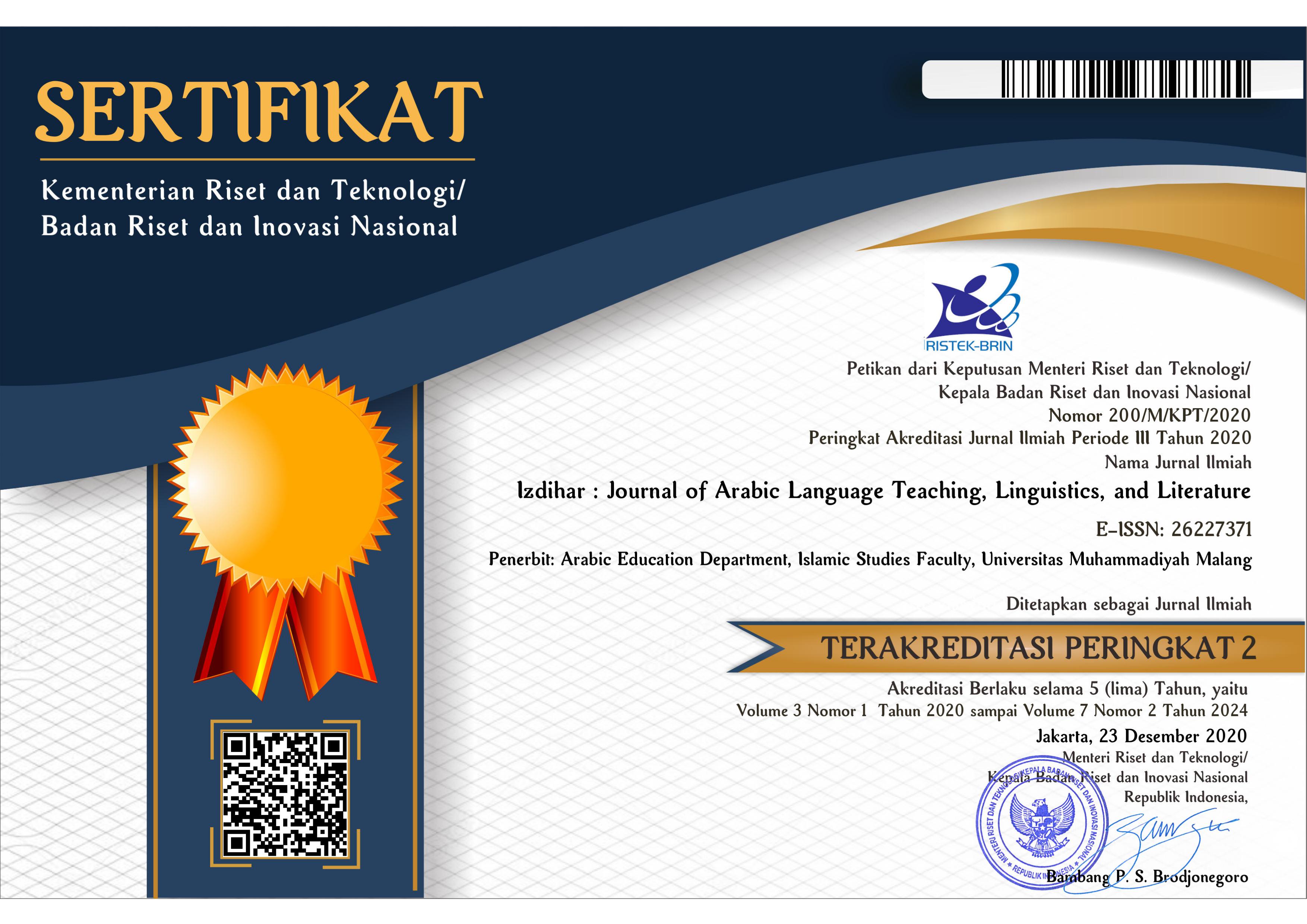The Development of CEFR-Based Nahwu and Shorof Learning Evaluation in Madrasah Aliyah in Cirebon
DOI:
https://doi.org/10.22219/jiz.v5i2.21610Keywords:
CEFR, Deveploment Learning Evaluation, Nahwu, ShorofAbstract
This study aims to determine the implementation and development of CEFR-based nahwu and shorof learning evaluations at MA An-Nur Jagasatru Cirebon. The research methodology used is the research and development method. In the development of this research, we used the Rowntree model, which was consisted of three stages, namely the planning stage, the development stage, and the evaluation stage. The trial phase began with the validation of material experts and linguists. Then, after being revised, the product was tested on class X students, namely 8 students for testing prototype 1 and 21 students for testing prototype 2. The results showed that the average score of material experts was 85%, which meant the product was considered very good, and linguists 88%, which meant the product was considered very good. Then at the testing stage of prototype 1, an average score of 64.37, which meant the product was considered quite good, and at the testing stage of prototype 2, an average score of 74.71, which meant it was considered very good. Based on interviews with teachers, they obtained very good results. Based on the results of the study, it can be concluded that the evaluation of nahwu and shorof learning based on CEFR is feasible and effective as an evaluation tool in nahwu and shorof learning, especially in MA An-Nur Jagasatru Cirebon.
Downloads
References
Ali, M. HF (2021). Transformasi dan Digitalisasi Pendidikan Dimasa Pandemi. In Prosiding Seminar Nasional Pendidikan Program Pascasarjana Universitas PGRI Palembang (pp. 15-16).
Ardiansyah, A. A., & Muhammad, A. (2020). Implementation of integrative Arabic grammar (Nahwu & Sharaf) curriculum in islamic boarding school. Izdihar: Journal of Arabic Language Teaching, Linguistics, and Literature, 3(3), 211–238. https://doi.org/10.22219/jiz.v3i3.13264
Arikunto, S. (2021). Dasar-dasar evaluasi pendidikan edisi III. PT Bhumi Aksara.
Asrori, I., Thohir, M., & Ainin, M. (2012). Evaluasi pembelajaran bahasa Arab. Misykat.
Chaqoqo, S. G. N. (2017). Evaluasi pembelajaran nahwu dalam bentuk munaqasyah di PP Al-Luqmaniyyah Yogyakarta. Lisania: Journal of Arabic Education and Literature, 1(1), 17–36. https://doi.org/https://doi.org/10.18326/lisania.v1i1.17-36
Dessiana Irma Yuanita, Hamdi Akhsan, K. W. (2015). Pengembangan panduan praktikum spektroskopi pada mata kuliah fisika modern. Jurnal Inovasi dan Pembelajaran Fisika, 2(1), 77–87. https://doi.org/https://doi.org/10.36706/jipf.v2i1.2357
Egok, A. S., & Hajani, T. J. (2018). Pengembangan multimedia interaktif pada pembelajaran IPA bagi siswa sekolah dasar Kota Lubuklinggau. Journal of Elementary School (JOES), 1(2), 141–157. https://doi.org/10.31539/joes.v1i2.446
Foley, J. A. (2019). Adapting CEFR for English language education in ASEAN, Japan and China. The New English Teacher, 13(2), 101–117.
He, L., & Chen, D. (2017). Developing common listening ability scales for Chinese learners of English. Language Testing in Asia, 7(1), 1-12. https://doi.org/10.1186/s40468-017-0033-4
Hermanto, B. (2020). Perekayasaan sistem pendidikan nasional untuk mencerdaskan kehidupan bangsa. FOUNDASIA, 11(2), 52-59. https://doi.org/10.21831/foundasia.v11i2.26933
Indayati, F., Saraswati, N. L., Rosalita, D. E., Imawan, J. S., & Dwi Febri. (2017). Ketimpangan Pendidikan dalam Perspektif Sosiologis di Indonesia. In Ketimpangan dalam Pembangunan: Bunga Rampai Realitas Sosial atas Ketimpangan Pembangunan di Indonesia. Media Nusa Creative.
Jamun, Y. M. (2018). The impact of technology on education. Jurnal Pendidikan dan Kebudayaan Missio, 10(1), 48-52.
Jinani, H. (2013). Pengembangan media evaluasi istima'dan qira'ah menggunaan hot potatoes 6 dalam pembelajaran bahasa Arab pada kelas VIII di MTs (Skripsi, Universitas Negeri Malang).
Kadi, T., & Awwaliyah, R. (2017). Inovasi pendidikan : Upaya penyelesaian problematika pendidikan di Indonesia. Jurnal Islam Nusantara, 1(2), 144-155. https://doi.org/10.33852/jurnalin.v1i2.32
Lubis, M. (2016). Peluang pemanfaatan pembelajaran berorientasi teknologi informasi di lingkup madrasah (mempersiapkan madrasah berwawasan global). Tadris: Jurnal Keguruan dan Ilmu Tarbiyah, 1(2), 147-153. https://doi.org/10.24042/tadris.v1i2.1063
Prasetya, M. A. (2021). Pengembangan evaluasi pembelajaran berbasis ispring pada mata pelajaran fisika pokok bahasan besaran dan satuan untuk sma kelas x. Seminar Nasional Pendidikan IPA, Vol. 1 (1).
Maryana, N., & Liudmyla, B. (2019). Intercultural competence in CEFR: Implementation in practice. The Scientific Issues of Ternopil Volodymyr Hnatiuk National Pedagogical University. Series: Pedagogy, 0(1). https://doi.org/10.25128/2415-3605.19.1.10
Ngafifi, M., & Ngafifi, M. (2014). Advances in Technology and Patterns of Human Life in Socio-Cultural Perspective. Jurnal Pembangunan Pendidikan: Fondasi Dan Aplikasi, 2(1), 33-47. https://doi.org/10.21831/JPPFA.V2I1.2616
Nugraha, M. H. (2017). Pengembangan Instrumen Pembelajaran Bahasa Arab berbasis Multimedia dengan Menggunakan Wondershare Quiz Creator. UPI Press.
Nurdianto, T., Hidayat, Y., & Wulandari, V. A. (2020). CEFR-based Arabic language learning competency. Izdihar: Journal of Arabic Language Teaching, Linguistics, and Literature, 3(3), 229-248. https://doi.org/10.22219/jiz.v3i3.14123
Nurkholis, N. (2013). Pendidikan dalam upaya memajukan teknologi. Jurnal kependidikan, 1(1), 24-44. https://doi.org/10.24090/jk.v1i1.530
Permatasari, D. P. R. P., & Aliyah, D. F. A. (2021, December). Kualitas Buku Teks Pembelajaran Bahasa Arab Di MAN 2 Surakarta Kelas X Bermuatan Kurikulum 2013 (Studi Komparasi Antara Buku Teks Bahasa Arab Wajib dan Bahasa Arab Peminatan). In Proceeding AEC (Arabic Education Conference) (Vol. 1, No. 1, pp. 139-150).
Poupounaki-Lappa, P., Peristeri, T., & Coniam, D. (2021). Towards a communicative test of reading and language use for Classical Greek. Journal of Classics Teaching, 22(44), 98-105. https://doi.org/10.1017/S2058631021000222
Basmar, E., Purba, B., Nugraha, N. A., Purba, E., Krisnawati, L., Damanik, D., ... & Siswanti, I. (2021). Perekonomian dan bisnis indonesia. Yayasan Kita Menulis.
Rahayu, E. E. (2014). Pengembangan alat evaluasi pembelajaran berbasis information and communication technologies (ICT) pada materi mengelola dokumen transaksi. Jurnal Pendidikan Akuntansi (JPAK), 2(2) 1-7. Retrieved from https://ejournal.unesa.ac.id/index.php/jpak/article/view/9139
Ridho, U. (2018). Evaluasi Dalam Pembelajaran Bahasa Arab. An Nabighoh Jurnal Pendidikan dan Pembelajaran Bahasa Arab, 20(01), 19-26. https://doi.org/10.32332/an-nabighoh.v20i01.1124
Hasibuan, H. (2016). Studi kompetensi guru Pendidikan Agama Islam dalam pelaksanaan evaluasi pembelajaran. In Forum Paedagogik, 8(2), 14-38.
Sa’adah, N. (2019). Problematika pembelajaran nahwu bagi tingkat pemula menggunakan Arab pegon. Lisanan Arabiya: Jurnal Pendidikan Bahasa Arab, 3(1), 15-32. https://doi.org/10.32699/liar.v3i01.995
Setiawan, D. (2018). Dampak perkembangan teknologi informasi dan komunikasi terhadap budaya. JURNAL SIMBOLIKA: Research and Learning in Communication Study (E-Journal), 4(1), 62-72. https://doi.org/10.31289/simbollika.v4i1.1474
Sibagariang, D., Sihotang, H., & Murniarti, E. (2021). Peran guru penggerak dalam pendidikan merdeka belajar di indonesia. Jurnal Dinamika Pendidikan, 14(2), 88-99.
Supardi. (2015). Penilaian Autentik. Raja Grafindo.
Nurdianto, T., & bin Ismail, N. A. (2020). Pembelajaran bahasa Arab Berbasis Common European Framework of Reference for Language (CEFR) di Indonesia. Al Mahāra: Jurnal Pendidikan Bahasa Arab, 6(1), 1-22. https://doi.org/10.14421/almahara.2020.061.01
Toriqul Arif, M. (2019). Penelitian evaluasi pendidikan. Addabana : Jurnal Pendidikan Agama Islam, 2(2), 66–76. https://doi.org/10.47732/adb.v2i2.122
Uri, N. F. M., & Aziz, M. S. A. (2020). The appropriacy and applicability of English assessment against CEFR global scale: Teachers’ judgement. 3L: Language, Linguistics, Literature, 26(3), 53-65. https://doi.org/10.17576/3L-2020-2603-05
Utomo, K., Soegeng, A. Y., Purnamasari, I., & Amaruddin, H. (2021). Pemecahan masalah kesulitan belajar siswa pada masa pandemi Covid19. Mimbar PGSD Undiksha, 9(1), 1-9. https://doi.org/10.23887/jjpgsd.v9i1.29923
Wahyono, I. (2019). Strategi kiai dalam mensukseskan pembelajaran nahwu dan shorof di Pondok Pesantren Al-Bidayah Tegalbesar Kaliwates Jember. Jurnal Tarbiyatuna: Kajian Pendidikan Islam, 3(2), 106-121. https://doi.org/10.29062/tarbiyatuna.v3i2.262
Westomi, J. A., Ibrahim, N., & Sukardjo, M. (2018). Pengembangan paket modul cetak mata pelajaran Pendidikan Agama Islam (PAI) untuk siswa SMA Negeri 1 Wangi-wangi Kabupaten Wakatobi. JTP - Jurnal Teknologi Pendidikan, 20(2), 138–151. https://doi.org/10.21009/jtp.v20i2.8628
Widiastuti, A., Rahelly, Y., & Sayfdaningsih, S. (2019). Pengembangan bahan ajar bentuk-bentuk geometri berbasis cerita untuk anak usia 5-6 tahun di TK Mazharul Iman Palembang. Jurnal Pendidikan Anak, 7(2), 176–189. https://doi.org/10.21831/jpa.v7i2.24461
Akhmadan, W. (2017). Pengembangan bahan ajar materi garis dan sudut menggunakan macromedia flash dan moodle kelas VII sekolah menengah pertama. Jurnal Gantang, 2(1), 27-40. https://doi.org/10.31629/jg.v2i1.62
Ng, H. Y., & Mohamad Zohir, A. (2021). Secondary school English teachers’ knowledge and practice on CEFR-aligned English curriculum. Asia Pacific Journal of Educators and Education, 36(1), 75-91. https://doi.org/10.21315/apjee2021.36.1.5
Yoshitomi, A. (2021). Developing an assessment system of speaking skills in English as a foreign language based on CEFR-J. Impact, 2021(2), 56-58. https://doi.org/10.21820/23987073.2021.2.56
Zazkia, S. A., & Hamami, T. (2021). Evaluasi kurikulum Pendidikan Agama Islam di tengah dinamika politik pendidikan di Indonesia. AT-TA'DIB: Jurnal Ilmiah Prodi Pendidikan Agama Islam, 82-93. https://doi.org/10.47498/tadib.v13i01.524
Zou, S., & Zhang, W. (2017). Exploring the adaptability of the CEFR in the construction of a writing ability scale for test for English majors. Language testing in Asia, 7(1), 1-16. https://doi.org/10.1186/s40468-017-0050-3
Downloads
Published
How to Cite
Issue
Section
License
Copyright (c) 2022 Zainal Arifin Ahmad, Irfan Hania, Faizmailiatus Sofa, Sri Utami, Putri Nurinadia, Muhammad Yusril Muna

This work is licensed under a Creative Commons Attribution-ShareAlike 4.0 International License.
Copyright Notice
Authors who publish with this journal agree to the following terms:
- Authors retain copyright and grant the journal right of first publication with the work simultaneously licensed under a Creative Commons Attribution-ShareAlike 4.0 International License that allows others to share the work with an acknowledgment of the work's authorship and initial publication in this journal.
- Authors are able to enter into separate, additional contractual arrangements for the non-exclusive distribution of the journal's published version of the work (e.g., post it to an institutional repository or publish it in a book), with an acknowledgment of its initial publication in this journal.
- Authors are permitted and encouraged to post their work online (e.g., in institutional repositories or on their website) prior to and during the submission process, as it can lead to productive exchanges, as well as earlier and greater citation of published work (See The Effect of Open Access).
Copyright (c) 2019 Izdihar : Journal of Arabic Language Teaching, Linguistics, and Literature

This work is licensed under a Creative Commons Attribution-ShareAlike 4.0 International License.

















